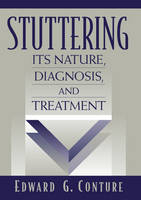
Stuttering
Pearson (Verlag)
978-0-205-31924-4 (ISBN)
- Titel ist leider vergriffen;
keine Neuauflage - Artikel merken
This highly readable, clinically oriented handbook combines theory and therapy and examines all facets of stuttering, from possible etiologies through assessment to treatment.
While considerable uncertainty still exists regarding the precise cause(s) of stuttering, Conture provides the reader with an even-handed coverage of fundamental knowledge, methodology, and procedures for effectively dealing with stuttering in children, teenagers, and adults. The book goes beyond a “how to” manual. Rather, Conture's clinical handbook provides both students and clinicians a source for principle-based procedures and strategies for the management of stuttering. Focusing on people who stutter as people first and people who stutter second, the text covers assessment and management of stuttering within the realities of everyday living, concomitant speech and language problems and clinical practice.
All chapters, except 6, conclude with a “Summary.”
1.Introduction.
What Is the Purpose of This Book?
What Is Stuttering?
How Do We Measure Stuttering?
What Nonspeech Behaviors Are Associated with Stuttering?
What Are Some Basic Generalizations about Stuttering?
What Are the Characteristics of People Who Stutter?
Why Do People Stutter? (Subtitled, What Causes Stuttering?)
Temporal Misalignment: An Essential Aspect of Many Modern-Day Theories of Stuttering.
General Orientation Toward the the Treatment of Stuttering and People Who Stutter.
How to Talk about Stuttering When Speaking with Clients and/or Families.
Recognizing Differences in People and Behavior.
Tolerating Differences in People and Behavior.
Enthusiasm for Changing People and Behavior.
The Common Cold and Stuttering.
Rationales versus Recipes.
2.Assessment and Evaluation.
Some Basic Beliefs That Guide Our Assessment Procedures.
Gaining Perspective on the Client's Unique Circumstances.
Examining the Examiner.
Facilities.
Equipment.
Informed Consent or the Client's Right-to-Know.
Components of the Stuttering Evaluation.
Assessing Communicative and Related Behaviors.
Who Is and Who Is Not Referred for Therapy.
3.Remediation: Children Who Stutter.
Stuttering Is a Disorder of Childhood.
The Clinician.
Therapy.
Young Children with No Communicative Problems Whose Parents Are Reasonably to Quite Concerned.
Children with Some Stuttering and Whose Parents Are Unconcerned.
Children with Some Stutterings Whose Parents Are Also Concerned.
Children with Some to a Great Deal of Stuttering and Whose Parents Are Reasonably to Somewhat Concerned.
4.Remediation: Older Children and Teenagers Who Stutter.
Older Children Are Not Just Older, They Are Different as Well.
Understanding the Parents of the Older Child and Teenager Who Stutter.
How Older Children Differ in General from Younger Children.
How Stuttering Problems of Older Children Who Stutter Differ from Those of Young People Who Stutter.
Older Children with Minimal or Little Awareness of Stuttering.
Desensitization.
Older Children with Definite (Cognitive/Emotional) Awareness of Stuttering.
Teenagers with Definite Awareness of Stuttering.
Some Parting Thoughts.
5.Remediation: Adults Who Stutter.
The General Lay of the Land.
Problem Dictates Procedure.
Group Therapy for Adults Who Stutter.
Individual Therapy for Adults Who Stutter: Starting Up.
Individual Therapy for Adults Who Stutter: Identification Phase.
Bridging between Identification and Modification.
Individual Therapy for Adults Who Stutter: Modification Phase.
Some Parting Thoughts.
6.Conclusions.
Basic Assumptions about Stuttering.
Evaluation Precedes Remediation.
Identification.
Modification.
Transfer.
Future Directions: General Considerations.
Future Directions: Opportunities.
Some Parting Thoughts.
References.
Appendix A. Interview Questions for the Parent(s) of a Disfluent Child.
Appendix B. Note to a Beginning Speech-Language Pathologist.
Appendix C. An Example of a Diagnostic Report for a Child Who Stutters.
Appendix D. Twelve Minus One Report-Writing Concerns.
Appendix E. Ten COmmon Mistakes Observed During a Diagnostic.
Appendix F. Children Who Stutter: Suggestions for the Classroom Teacher.
| Erscheint lt. Verlag | 23.3.2001 |
|---|---|
| Sprache | englisch |
| Maße | 242 x 186 mm |
| Gewicht | 744 g |
| Themenwelt | Medizin / Pharmazie ► Gesundheitsfachberufe ► Logopädie |
| ISBN-10 | 0-205-31924-6 / 0205319246 |
| ISBN-13 | 978-0-205-31924-4 / 9780205319244 |
| Zustand | Neuware |
| Haben Sie eine Frage zum Produkt? |
aus dem Bereich


